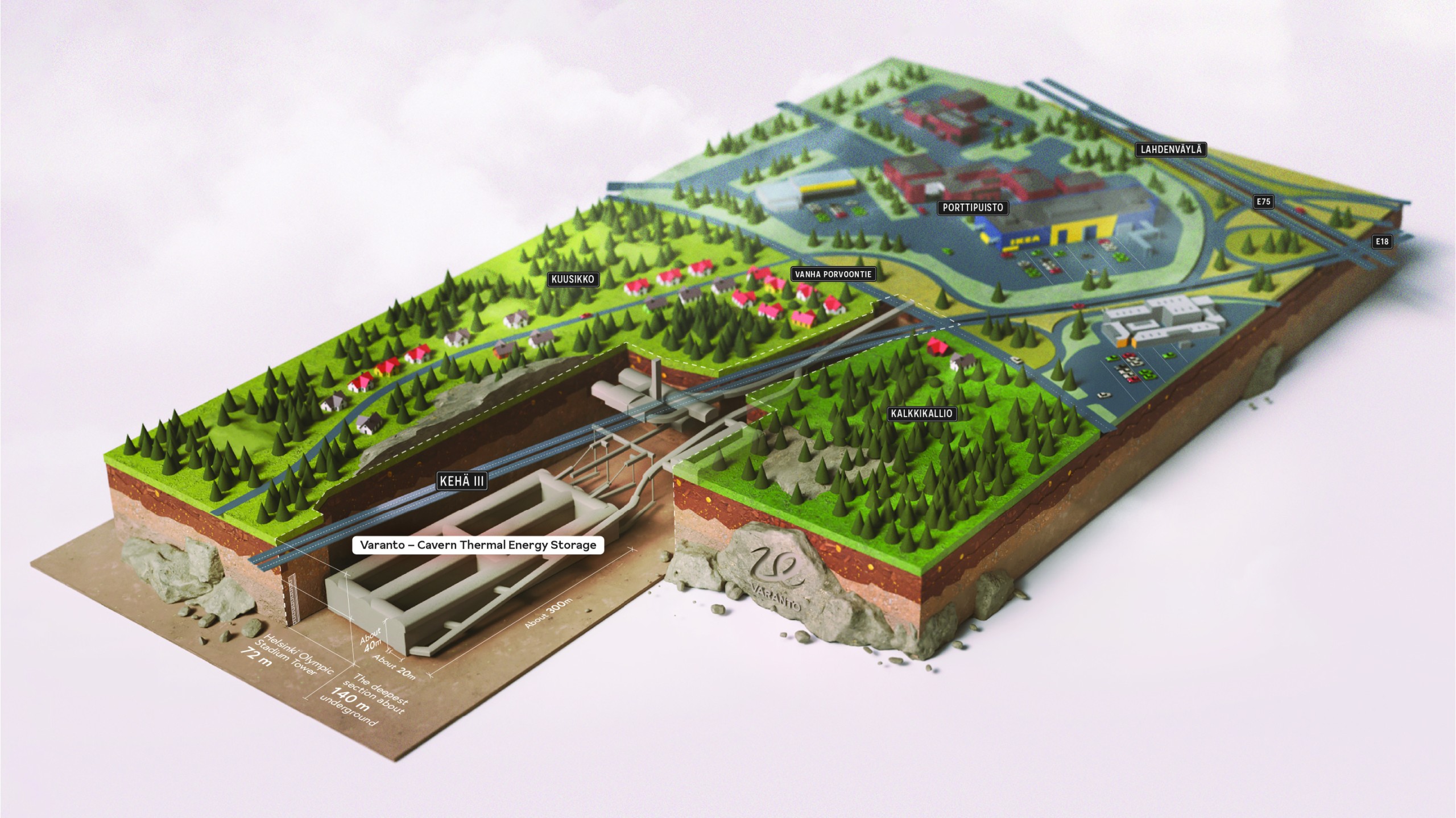- cross-posted to:
- climate@slrpnk.net
- collapse@sopuli.xyz
- cross-posted to:
- climate@slrpnk.net
- collapse@sopuli.xyz
A seasonal thermal energy storage will be built in Vantaa, which is Finland’s fourth largest city neighboring the capital of Helsinki.
The total thermal capacity of the fully charged seasonal thermal energy storage is 90 gigawatt-hours. This capacity could heat a medium-sized Finnish city for as long as a year. Broken down into smaller energy units, this amount of energy is equivalent to, for example, 1.3 million electric car batteries.
The project cost is estimated to be around 200 million euros, and it has already been awarded a 19-million-euro investment grant from Finland’s Ministry of Economic Affairs and Employment. Construction of the storage facility’s entrance is expected to start in summer 2024. The seasonal thermal energy storage facility could be operational in 2028.
They’re calling it a “thermal energy storage” for grant money. It’s a sauna.
Well, powering all their saunas with this wouldn’t be too bad either!
This sounds so cool. I really hope other cities and countries will do similar things, it sounds really neat to store electricity when it’s cheap and also use “heat waste” from datacenters and such.
200m isn’t very expensive, right?
I think it depends. I am really no expert in costs for energy storage and it would really be interesting to see if this projects tackles high energy costs in the long run and in which way. But if I compare the costs with the costs of building this storage and costs of highways construction in Europe, just to put it in some perspective, it does not seem to be much money.
https://www.worldhighways.com/news/european-highway-construction-costs-evaluated
The information is old, but this sum would roughly buy you 20km Highway in Slovakia. Which is not much.
Much cheaper than equivalent nuclear power plants or offshore wind parks
Sure, though a battery only stores energy but doesn’t create it so the comparison isn’t ideal
Why can’t we store energy generated by wind turbines this way?
I live in Denmark and we sell electricity to Germany but when it is windy, Germany asks Denmark to stop their energy production because prices are getting too low. They actually pay turbine owners money to not make electricity when its windy!
Why not simply convert the unsaleable e ectricity it to heat and store it to be spend when its needed as heat?
Because there is no “simply store” yet. Efficiently storing energy is not really solved. There are lots of snake-oil companies with braindead ideas (like lifting blocks of concrete to build a tower). But heating water and storing it like this seems like a feasible option. Very cool but expensive… I do hope it works.
Artificial lakes / Pumped-storage hydroelectricity sounds a lot more reasonable than heating water. And it already exists
The problem with pumping is low energy density, especiall when compared to deating water. Heating 1 kg of water by 1°C requires 4186 joules of energy. So to store the same energy by “lifting” water, it would require 4186 j / (1 kg * 9.81 m/s^2) = 426 m of height difference. This value seems unbelievable, but I have triple checked it. And that is only 1 degree of difference, 50 degrees difference would equal 27 km of height difference.
Yes. The problem is that the best locations for harvesting wind energy are flat and the best places to pump store energy ideally needs some terraine
The problem with heating water is, afaik, that its not that easy to convert it back into electricity.
But based on this article it seems like they just store heat and reuse it as heat when needed.
It sounds plausible to simply convert excess electricity to heat and simply use it with heat is neededIt’s not easy but we are trying!
That’s cool as hell.
Unless you heat it to about 400°C like in every steam-electric thermal power station. To store such temperatures, it’s better to melt metal or something.
They recently built a pilot plant that seems to go way beyond the prototype stage at 100 MWh. This technology obviously still has a long way to go to mainstream adoption, but just writing it off because it seems farfetched is pretty shortsighted.
Well, I’m still sceptic and the marketing driven website low in details doesn’t really help. Most of these projects conveniently forget the whole supply chain for the needed resources. But if it works, then great! The more solutions we have the more chance we have as humanity to survive.
Well, they’re building the thing. Then they’ll be running the thing for a while. Then we’ll see if it really works technically and economically.
I wouldnt really call being able to sub in for 10 wind turbines for 4 hours “way beyond the prototype stage”. Especially given its losing 1 in 5 joules generated and require a fuckload of concrete to construct.
Part of the reason this is even worth doing is that they already have the district heating infrastructure in place to pipe the hot water out to buildings to be used for heat. This storage system is basically an add-on to that infrastructure.
This is made possible by the underground district heating network that most properties are connected to. There are more than 600 kilometers of underground district heating networks in Vantaa. Around 90% of Vantaa residents live in a home heated by district heating.
So if you have a city that already has such a hot water piping network in place and has nearby
natural cavesbedrock that can be easily accessed and used in this way, then the cost of implementation is low.If you don’t have the heat piping infrastructure then it’s a heavy lift to retofit it into all the existing buildings. Doable, but it will take a lot of time and resources.
If you don’t have the caves then this is just a non-starter.*edit: So I got that wrong, they’re apparently going to be digging (or blasting?) new holes into bedrock for the water storage. I guess you could do this anywhere where there was bedrock relatively close to ground level (I’m not a geologist, I assume it would depend somewhat on the type of rock).
I’m curious how they’re going to make building-sized holes in the rock relatively cheaply. Typically every kind of earthmoving is expensive. If we’re talking granite with an average density of 2.7 g/cm3 (2700 kg/m3) then they plan to move 3 billion kg (3 million metric tons) of rock.
I understand. Here we do have heating delivered by heating pipes. Heat comes from local energy plants.
We dont have caves though but storing heat underground should be doable i assume
It just feels silly to spend money on not making electricity instead of spending money on storing even just some of it in any kind of energy form.
My theory is that energy is still seen at as a resource instead of a flow. We won’t run out of wind energy. We will only get more and more of it. We shouldn’t care quite as much on how effectively we can convert or store it imo
It’s not that, it’s storing the excess energy and converting it to heat, and that heat is then transferred to homes and thus reducing the use of electricity in the winter. Most of the electricity usage of Finland is in heating during winter. So using excess to store heat is a great idea, and using existing infrastructure to boot.
Great!
So instead of paying money to turn off electricity generation when its cheapest, why not simply generate heat and store it in a similar way during those periods?
There is a difference between electricity and thermal energy.
I don’t know the details, but it’s highly likely that they are using waste heat from power generation or industrial processes here. They are not going to be using excess renewable energy.
To use excess wind or solar to generate thermal energy, you would need to invest in extra grid capacity, or electric energy storage (e.g. batteries, which are much more expensive) and either use heat pumps, or resistive elements, which would then require even more grid capacity.
And even if you would do all of that, you would only have excess renewable energy a few hundred hours per year, so it will not pay for itself






